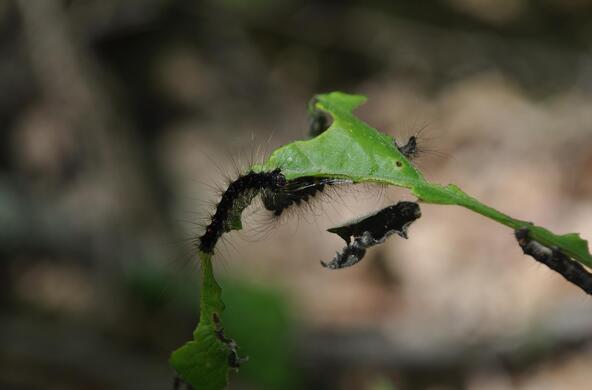The arrival of spring signals the start of a new field work season on Cary’s campus. As they have for more than 30 years, Cary Institute researchers return to the forest to collect ticks, trap rodents, and monitor other ecological factors to better estimate the abundance of blacklegged ticks, the main vectors of pathogens that cause Lyme disease, babesiosis, and anaplasmosis. By revealing important links between ecological conditions and tick populations, the study helps to predict when the risk of tick-borne disease will be high in the Hudson Valley and other parts of the Northeast, informing increased vigilance for people who spend time outdoors.
This year, the field work looks a little different. Disease ecologists Richard Ostfeld and Shannon LaDeau will also be investigating how the 2024 spongy moth outbreak influences the survival of the blacklegged menace, and keeping an eye out for two newly arrived tick species.
“These new questions are united by our tendency to move species around the planet, sometimes inadvertently,” Ostfeld explained. “Species that come from elsewhere can be damaging to local ecosystems, where they may not have natural enemies or other forces that can regulate them. They can also bring diseases that are novel to our area.”
The new threads of research will be interwoven with and informed by the project’s continued long-term monitoring efforts.
“These systems that we're studying are very dynamic,” said Ostfeld. “They're in flux, and this project has always made it a priority to be able to pivot and adapt to be responsive to those fluxes.”
Spongy moth aftermath
Native to Eurasia, spongy moths were brought to the US in 1869 in what Ostfeld describes as a “hare-brained scheme” to produce silk. Unfortunately, he added, “they're terrible when it comes to producing anything that can be developed into a fabric. But they're really good at killing trees.” Spongy moths have invaded forests throughout the northeastern US and parts of the Midwest.
Cary’s campus was hit hard by spongy moth caterpillars in 2024. Defoliation of oak trees — the caterpillars’ favorite food — reached nearly 100%, and other species, including evergreens, suffered significant damage. Much of the Mid-Hudson Valley region was denuded before the caterpillars died or retreated into cocoons, allowing the trees to unfold new leaves.

Because Ostfeld, LaDeau, and team had already been studying how heat and humidity impact tick survival, they realized the sudden increase in light on the forest floor due to defoliation might have serious implications for ticks and the diseases they carry.
“We know from our previous research that if it's very warm and dry, that's really bad for some life stages of ticks,” said Ostfeld. “On the other hand, warm and wet conditions favor tick survival. So if this defoliation by the spongy moths is changing temperature and humidity conditions on the ground, it could influence their survival, and as a consequence, our risk of getting sick from tick-borne disease.”
With a RAPID grant from the National Science Foundation, the team sprang into action to measure the impacts. They began by setting up 144 mesh enclosures last fall. The enclosures are bags made of white organza. Each bag contains soil and leaf litter, two data loggers the size of watch batteries that record temperature and humidity, and a certain number of locally collected blacklegged ticks. Over the next few months, the team comes back every few weeks to count how many of the trapped ticks survived.
Under the RAPID grant, the tick enclosures are evenly deployed in three kinds of conditions: heavily defoliated areas, areas with lower defoliation, and in defoliated locations under a shade cloth to simulate an intact canopy. The team measures tick survival under each condition, and with each tick life stage. They started with larvae in September and adults in November. Next they’ll deploy nymphs in May. These months correspond to the times of year that each stage is most active.
The study will clarify how dramatic ecological changes influence tick survival, and what that means for people. LaDeau is eager to plug their findings into a custom model she has been developing with collaborators to generate real-time forecasts of tick populations and local risk of Lyme disease. Finding out whether the ticks thrive or “take it on the chin,” in Ostfeld’s words, may turn out to be key to understanding that risk over the next few years.
Learning more about what causes variation in tick survival could also lead to new tools for controlling tick-borne disease. “We're always hungry for more information,” Ostfeld said, “which can be used to educate the public about taking personal protective measures. But it could also be that the mechanisms that cause tick mortality can be harnessed to help us control tick populations in a way that's safe for the environment.”
New ticks in town
Two tick species are invading the Hudson Valley, with the potential to introduce new diseases into the region. Ostfeld and LaDeau hope to secure funding to begin answering questions about the species’ abundance, what pathogens they carry, and what impact their presence will have on human health.
One of the invaders, the lone star tick, has been rapidly expanding its range from the southeastern US to the Northeast — assisted, no doubt, by warming temperatures caused by climate change. This tick is responsible for transmitting STARI (southern tick-associated rash illness), ehrlichiosis, as well as Heartland virus and Bourbon virus, which can be fatal. Bites from the lone star tick can cause an allergy to red meat called alpha-gal syndrome.

Cary Institute scientists have already detected a small number of lone star ticks on campus, but Ostfeld worries “it could explode in numbers or in contact with humans, our pets, our livestock, and with wild animals.”
The second invader, the longhorned tick, is native to East Asia, although it is not clear how they came to be in New Jersey in 2017. Spreading from there, the species has now been detected at research sites less than 20 miles southwest of Cary’s campus.

Mostly a threat to livestock — a single animal can carry thousands of ticks and even die of blood loss — the longhorned tick is also known to bite people, wild animals, and companion animals. It can transmit the virus that causes severe fever with thrombocytopenia syndrome (SFTS).
Neither of these invasive ticks is found in particularly large numbers in our region — yet. But Ostfeld and LaDeau suspect that they will soon be seen in increasing numbers, and over a larger range.
While their current monitoring efforts may occasionally pick up a stray lone star or longhorned tick, the new ticks tend to prefer more open and grassy habitats than the forested field sites that the project currently monitors. An early warning system for these ticks would require the team to expand to new sites that would help to reveal where these ticks are, what habitat types they’re using, where they’re moving, and how rapidly they're moving from one year to the next.
By detecting the invasion early, Ostfeld and LaDeau hope to reduce risk to people and make sure that the agriculture industry, pet care providers, and the healthcare community have the information they need to take precautions.
With its decades-long legacy of tick research, Cary Institute is uniquely positioned to detect these new invaders and measure their impacts.
“Recognizing these important disruptions to the system was only possible because we had an ongoing, long-term study,” said LaDeau. “The 30 years of consistent tick, host, and pathogen data at Cary Institute are a unique and powerful example of fundamental research that allows for new questions to arise, and it is poised to develop real answers.”








